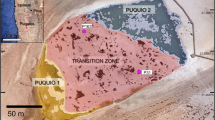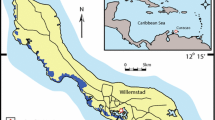Abstract
Bacteria are able to form carbonate rocks and minerals at all scales, from deposits many meters thick, to distinctive shrubs, to minute crystal forms. They are particularly common in peloids, stromatolites, and hot-water travertines. The peculiar crystal morphologies they produce can be duplicated in the laboratory. Nanobacteria are much smaller forms, spheroids 0.03–0.1 µm in diameter. A quantitative census of nanobacterial bodies in limestones from Holocene to Proterozoic, and in micrite vs ooids vs sparry calcite show that the abundance is enormously variable. In a 4 µm2 area, most samples studied contain between one and 16 bacterial bodies; the median value is about four. Bacteria are significant producers of carbonate deposits.
Access this chapter
Tax calculation will be finalised at checkout
Purchases are for personal use only
Preview
Unable to display preview. Download preview PDF.
Similar content being viewed by others
References
Aitken JD (1967) Classification and environmental significance of cryptalgal limestones and dolomites, with illustrations from the Cambrian and Ordovician of southwestern Alberta. J Sedimentary Petrol 37: 1163–1178
Boquet E, Boronat A, Ramos-Cormenzana A (1973) Production of calcite (calcium carbonate) crystals by soil bacteria is a general phenomenon. Nature 246: 527–529
Buczynski C, Chafetz HS (1991) Habit of bacterially induced precipitates of calcium carbonate and the influence of medium viscosity on mineralogy. J Sedimentary Petrol 61: 226–233
Buczynski C, Chafetz HS (1993) Habit of bacterially induced precipitates of calcium carbonate: examples from laboratory experiments and recent sediments. In: Rezak R, Lavoie D (eds) Carbonate microfabrics. Springer, Berlin Heidelberg New York, pp 105–116
Chafetz HS (1986) Marine peloids: a product of bacterially induced precipitation of calcite. J Sedimentary Petrol 56: 812–817
Chafetz HS (1994) Bacterially induced precipitates of calcium carbonate and lithification of microbial mats. In: Krumbein WE, Paterson DM, Stal LJ (eds) Biostabilization of sediments. Oldenburg Press, Oldenburg, p 526
Chafetz HS, Buczynski C (1992) Bacterially induced lithification of microbial mats. Palaios 7: 277–293
Chafetz HS, Folk RL (1984) Travertines: Depositional morphology and the bacterially constructed constituents. J Sedimentary Petrol 54: 289–316
Chafetz HS, Meredith JC (1983) Recent travertine pisoliths (pisoids) from southeastern Idaho, USA. In: Peryt TM (ed) Coated grains. Springer, Berlin Heidelberg New York, pp 450–455
Chafetz HS, Rush PF, Utech NM (1991) Microenvironmental controls on mineralogy and habit of CaCO3 precipitates: an example from an active travertine system. Sedimentology 38: 107–126
Dalrymple DW (1965) Calcium carbonate deposition associated with blue-green algal mats, Baffin Bay, Texas. Univ Texas Inst Mar Sci 10: 187–200
Deelman JC (1975) Two mechanisms of microbial carbonate precipitation. Naturwissenschaften 62: 484–485
Drew GH (1911) The action of some denitrifying bacteria in tropical and temperate seas, and the bacterial precipitation of calcium carbonate in the sea. J Mar Biol Assoc UK 9: 142–155
Drew GH (1913) On the precipitation of calcium carbonate in the sea by marine bacteria, and on the action of denitrifying bacteria in tropical and temperate seas. J Mar Biol Assoc UK 9: 479–524
Folk RL (1990) Bacteria and carbonate precipitation in Sulfurous Hot Springs, Viterbo, Lazio, Italy, (abs.). 13th Int Sedimentological Congr, Nottingham, p 172
Folk RL (1992) Bacteria and nanobacteria revealed in hardgrounds, calcite cements, native sulfur, sulfide minerals and (yes) travertines (Abstr). Cincinnati, Ohio, Oct 26–29, 1992, Geological Society America, Abstracts with Programs 18: A-1o4
Folk RL (1993a) Dolomite and dwarf bacteria (nanobacteria) (Abstr). Geological Society America, Abstracts with Programs 19: A-397
Folk RL (1993b) SEM imagining of bacteria and nanobacteria in carbonate sediments and rocks. J Sedimentary Petrol 63: 990–999
Folk RL (1994) Interaction between bacteria, nanobacteria and mineral precipitation in hot springs of Central Italy. Geogr Phys Quat 48: 233–246
Folk RL, Chafetz HS (1983) Pisoliths (pisoids) in quaternary travertines of Tivoli, Italy. In: Peryt TM (ed) Coated Grains. Springer, Berlin Heidelberg New York, pp 474–487
Folk RL, Lynch FL (1997) The possible role of nanobacteria (dwarf bacteria) in clay mineral diagenesis and the importance of careful sample preparation in high magnification SEM study. J Sedimentary Res: 67
Folk RL, Lynch FL, Major RP (1996) The role of nanobacteria (dwarf bacteria) in the formation of ooids and hardgrounds, Jo-utters Cays, Bahamas. Geological Society of America, Abstracts with Programs, 22: A-275
Folk RL, Lynch FL, Rasbury ET (1994) Evidence for bacterial precipitation of clay minerals upon sand grains. In: soils, and in the subsurface (Abstr): Geological Society America, Abstracts with Programs 20: A-308
Folk RL, Noble PJ, Gelato G, McLean RJC (1995) Precipitation of opal - CT lepispheres, chalcedony and chert nodules by nano-bacteria (dwarf bacteria) (Abstr). New Orleans, Louisiana, Nov. 6–9,1995, Geological Society America, Abstracts with Programs 21: A-305
Garcia-Mondejar J, Fernandez-Mendiola PA (1995) Albian carbonate mounds: Comparative study in the context of sea-level variations (Soba, northern Spain) In: Monty CLV, Bosence DWJ, Bridges PH, Pratt BR (eds) Carbonate mud-mounds: their origin and evolution. Blackwell Science, Oxford, International Association of Sedimentologists, Special Publication 23: 359–384
Gerundo M, Schwartz GL (1949) The role of denitrifying bacteria in the genesis of formations found in the Carlsbad Cavern. Texas J Sci 1: 58–61
Greenfield LJ (196) Metabolism and concentration of calcium and magnesium and precipitation of calcium carbonate by a marine bacterium. Ann NY Acad Sci 109: 23–45
Grotzinger JP, Read JF (1983) Evidence for primary aragonite precipitation, Lower Proterozoic (1.9 Ga) Rocknest Dolomite, Wopmay Orogen, NW. Canada. Geology 11: 710–713
Horodyski RJ, Bloeser B, Yonder Haar S (1977) Laminated algal mats from a coastal lagoon, Laguna Mormona, Baja California, Mexico. J Sedimentary Petrol 47: 680–696
Kellerman KF, Smith NR (1914) Bacterial precipitation of calcium carbonate. J Wash Acad Sci 4: 400–402
Kennard JM, James NP (1986) Thrombolites and stromatolites: two distinct types of microbial structures. Palaios 1: 492–503
Kreitler CW, Dutton S.P (1983) Origin and diagenesis of cap rock, Gyp Hill and Oakwood Salt Domes, Texas. Report of Investigations no 131, Bureau of Economic Geology, Univ Texas, Austin, Texas, p 58 p
Krumbein WE (1979) Photolithotropic and chemoorganotrophic activity of bacteria and algae as related to beachrock formation and degradation (Gulf of Aquaba, Sinai). Geomicrobiol J 1: 139–203
Krumbein WE, Cohen Y (1974) Biogene, klastische and evaporitische Sedimentation in einem mesothermen monomiktischen ufernahen See ( Golf von Aqaba ). Geol Rundsch 63: 1035–1065
Krumbein WE, Cohen Y (1977) Primary production, mat formation and lithification: contributions of oxygenic and facultative anoxygenic cyanobacteria. In: Flugel E (ed) Fossil algae, recent results and developments. Springer, Berlin Heidelberg New York, pp 37–56
Krumbein WE, Cohen Y, Shilo M (1977) Solar Lake (sinai), IV. Stro- matolitic cyanobacterial mats. Limnol Oceanogr 22: 635–656
Lalou C (1957) Studies on bacterial precipitation of carbonates in sea water. J Sedimentary Petrol 27: 190–195
Land LS (1971) Submarine lithification of Jamaican reefs. In: Brikker OP (ed) Carbonate cements. Johns Hopkins Univ, Baltimore, Maryland, Stud Geol 19: 59–62
Land LS, Goreau TF (1970) Submarine lithification of Jamaican reefs. J Sedimentary Petrol 40: 457–462
Land LS, Moore CH (1980) Lithification, micritization and syndepositional diagenesis of biolithites on the Jamaican Island slope. J Sedimentary Petrol 50: 357–370
Leinfelder RR, Nose M, Schmid DU, Werner W (1993) Microbial crusts of the Late Jurassic: composition, palaeoecological significance and importance in reef construction. Facies 29: 195–230
Lighty, R.G (1985) Preservation of internal reef porosity and diagenetic sealing of submerged early Holocene barrier reef, southeast Florida shelf. In: Schneidermann N, Harris PM (eds) Carbonate cements. Society of Economic Paleontologists and Mineralogists, Tulsa, Oklahoma, Special Publication 36: 123–151
Macintyre IG (1977) Distribution of submarinecements in a modern Caribbean fringing reef, Galeta Point, Panama. J Sedimentary Petrol 47: 503–516
Macintyre IG (1985) Submarine cements–the peloidal question. In: Schneidermann N, Harris PM (eds) Carbonate cements. Society of Economic Paleontologists and Mineralogists, Tulsa, Oklahoma, Special Publication 36: 109–116
McCallum MF, Guhathakurta K (1970) The precipitation of calcium carbonate from seawater by bacteria isolated from Bahama Bank sediments. J Appl Bacterial 33: 649–655
Mock SE, Palmer TJ (1991) Preservation of siliceous sponges in the Jurassic of southern England and northern France. J Geol Soc Lond 148: 681–689
Monaghan H, Lytle ML (1956) The origin of calcareous ooliths. J Sedimentary Petrol 26: 111–118
Monty CLV (1965) Geological and environmental significance of Cyanophyta. Unpubl. PhD Dissertation, Princeton University, Princeton, New Jersey
Monty CLV (1995) The rise and nature of carbonate mud-mounds: an introductory actualistic approach. In: Monty CLV, Bosence DWJ, Bridges PH, Pratt BR (eds) Carbonate mud-mounds: their origin and evolution. Blackwell Science, Oxford, International Association of Sedimentologists, Special Publication 23: 11–48
Monty CLV, Bosence DWJ, Bridges PH, Pratt BR (1995) Carbonate Mud-Mounds: their origin and evolution, Blackwell Science, Oxford, International Association of Sedimentologists
Morita RY (1980) Calcite precipitation by marine bacteria. Geomicrobiol J 2: 63–82
Morita RY (1988) Bioavailability of energy and its relationship to growth and starvation survival in nature: Can J Microbiol 34: 436–446
Novitsky JA (1981) Calcium carbonate precipitation by marine bacteria. Geomicrobiol J 2: 375–388
Neuweiler F (1993) Development of Albian microbialites and microbialite reefs at marginal platform areas of the Vasco-Cantabrian Basin (Soba Reef Area, Cantabria, N. Spain). Facies 29: 231–250
Oppenheimer CH (1961) Note on the formation of spherical aragonite bodies in the presence of bacteria from the Bahama Bank. Geochim Cosmochim Acta 23295–296
Pedone VA, Folk RL (1996) Formation of aragonite cement by nanobacteria in the Great Salt Lake, Utah. Geology 24: 763–765
Pratt BR (1995) The origin, biota and evolution of deep-water mudmounds. In: Monty CLV, Bosence DWJ, Bridges PH, Pratt BR (eds) Carbonate mud-mounds: their origin and evolution. Blackwell Science, Oxford, International Association of Sedimentologists, Special Publication 23: 49–123
Reid RP (1987) Nonskeletal peloidal precipitates in Upper Triassic reefs, Yukon Territory (Canada). J Sedimentary Petrol 57: 893–900
Reitner J (1993) Modern cryptic microbialite/metazoan facies from Lizard Island (Great Barrier Reef, Australia): formation and concepts. Facies 29: 3–40
Roberts HH, Aharon P, Walsh MM (1993) Cold-seep carbonates of the Louisiana contiental slope-to-basin floor. In: Rezak R, Lavoie D (eds) Carbonate microfabrics. Springer, Berlin Heidelberg New York, pp 95–104
Soudry D, Weissbrod T (1995) Morphogenesis and facies relationships of thrombolites and siliciclastic stromatolites in a Cambrian tidal sequence ( Flat area, southern Israel ). Palaeogeogr Palaeoclimatol Palaeoecol 114: 339–355
Sun SQ, Wright VP (1989) Peloidal fabrics in Upper Jurassic reefal limestones, Weald Basin, southern England. Sedimentary Geol 65: 165–181
Tiezzi A, Folk RL (1984) Vacuole-rich cements in Mississippian stromatactis and quaternary travertines: the bacterial connection. Society Economic Paleontologists and Mineralogists Midyear Meeting, San Jose, California, Abstract, p 82
Vasconcelos C, McKenzie JA (1994) The microbial dolomite model: Anaerobe-induced dolomite precipitation and early diagenesis in a modern shallow-water lagoon (Lagoa Vermelho, Brazil) (Abstr). Geological Society America Annual Meeting, Seattle, A-5089
Vasconcelos C, McKenzie JA, Bernasconi S, Grujic D, Tien AJ (1995) Microbial mediation as a possible mechanism for natural dolomite formation at low temperatures. Nature 377: 220–222
Author information
Authors and Affiliations
Editor information
Editors and Affiliations
Rights and permissions
Copyright information
© 2000 Springer-Verlag Berlin Heidelberg
About this chapter
Cite this chapter
Folk, R.L., Chafetz, H.S. (2000). Bacterially Induced Microscale and Nanoscale Carbonate Precipitates. In: Riding, R.E., Awramik, S.M. (eds) Microbial Sediments. Springer, Berlin, Heidelberg. https://doi.org/10.1007/978-3-662-04036-2_6
Download citation
DOI: https://doi.org/10.1007/978-3-662-04036-2_6
Publisher Name: Springer, Berlin, Heidelberg
Print ISBN: 978-3-642-08275-7
Online ISBN: 978-3-662-04036-2
eBook Packages: Springer Book Archive




